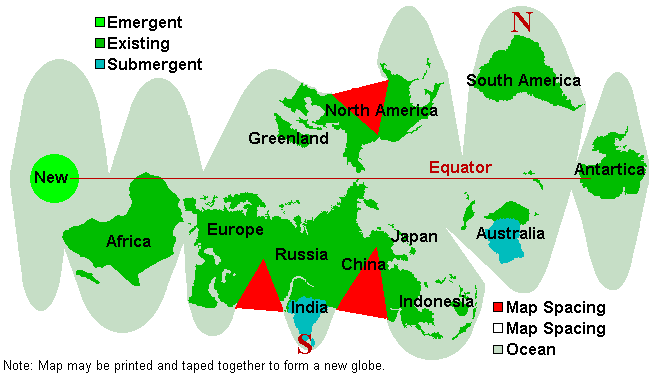
| |
 |

After the pole shift the Earth begins rotating again, with its new poles in the same relative position to the Solar System as today. In other words, whatever part of the Earth is North, magnetically, after the shift, will become the new North Pole. The pole shift, with consequent realignment of the poles, will place the New Equator over formerly frozen lands. Greenland, Canada, Alaska, Siberia, and Europe will be affected by the new equator. This will not mean that these areas will be lush, right away. The temperate zones, not all that lush to begin with, will find themselves after the cataclysms in a warm state, but with little vegetation. Past cataclysms have regularly rearranged the Earth's geography and climate zones, as the Earth attests. The continents, once one large land mass, were torn apart, temperate or tropical areas suddenly freezing up and covering over with ice and snow that never melts, and frozen wastelands gradually melting and warming to sustain life once again. Mountains in mountain building areas were pushed higher and subducting plates were suddenly slid under the overplate.
While the land rearranges the oceans slosh about but eventually settle into the lower areas. Coastal spots that had formerly been above the water line may now be under the waves, and likewise plates that had been submerged may now be dry land. How much land pokes above the waves depends on how deep and wide the ocean rifts are, but historically the land mass in total has remained the same. Continents do not disappear, but plates abutting continents or close to the ocean surface may rise and fall, depending on the plate action around the site and elsewhere around the globe. If plate action thrusts formerly submerged land out from under the sea, then the settling oceans have less area to settle into and consequently beaches worldwide may rise. Likewise, a sudden yaw in a mid-ocean rift may cause beaches worldwide to drop, but inevitably the yaw is matched by a crunch elsewhere, where land will subduct.
After a pole shift the former poles invariably melt and soften while the new poles take on layer after layer of ice and snow. This pace is not matched, as polar cap building only stabilizes at a point where evaporation and melting at glacial edges equals the arrival of newly fallen snow after some centuries. In the meantime the Waters Rise worldwide, several hundred feet, and then recede again. This pace is gradual, so that coastal settlements have plenty of time to relocate, an exercise they find they must do repeatedly.